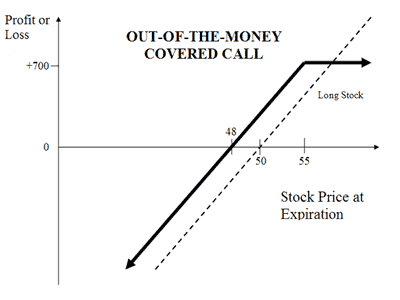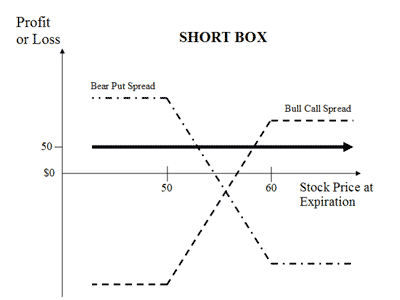 Zerodha (Trading Account)
Zerodha (Trading Account)
FREE Equity Delivery and MF
Flat ₹20/trade Intra-day/F&O
 Zerodha (Trading Account)
Zerodha (Trading Account)
FREE Equity Delivery and MF
Flat ₹20/trade Intra-day/F&O

|
|
Compare Covered Call and Short Box (Arbitrage) options trading strategies. Find similarities and differences between Covered Call and Short Box (Arbitrage) strategies. Find the best options trading strategy for your trading needs.
| Covered Call | Short Box (Arbitrage) | |
|---|---|---|
 |
 |
|
| About Strategy | A Covered Call is a basic option trading strategy frequently used by traders to protect their huge share holdings. It is a strategy in which you own shares of a company and Sell OTM Call Option of the company in similar proportion. The Call Option would not get exercised unless the stock price increases. Till then you will earn the Premium. This a unlimited risk and limited reward strategy. Let's assume you own TCS Shares and your view is that its price will rise in the near future. You will Sell OTM Call Option of TCS at a price, where you target to sell your shares. You will receive premium amount for selling the Call option and the premium is your income. | Short Box is an arbitrage strategy. It involves selling a Bull Call Spread (1 ITM and I OTM Call) together with the corresponding Bear Put Spread (1 ITM and 1 OTM Put), with both spreads having the same strike prices and expiration dates. The short box strategy is opposite to Long Box (or Box Spread). It is used when the spreads are overpriced with respect to their combined expiration value. This strategy is the combination of 2 spreads (4 trades) and the profit/loss calculated together as 1 trade. Note that the 'total cost of the box remain same' irrespective to the price movement of underlying security in any direction. The expiration value of the box spread is actually the difference between the strike prices of the options involved. ... Read More |
| Market View | Bullish | Neutral |
| Strategy Level | Advance | Advance |
| Options Type | Call + Underlying | Call + Put |
| Number of Positions | 2 | 4 |
| Risk Profile | Unlimited | None |
| Reward Profile | Limited | Limited |
| Breakeven Point | Purchase Price of Underlying- Premium Recieved | |
| Covered Call | Short Box (Arbitrage) | |
|---|---|---|
| When to use? | The covered call option strategy works well when you have a mildly Bullish market view and you expect the price of your holdings to moderately rise in future. |
Being risks free arbitrage strategy, this strategy can earn better return than earnings in interest from fixed deposits for any investor. The earning from this strategy varies with the strike price chosen by the trader. i.e. Earning from strike price '10400, 10700' will be different from strike price combination of '9800,11000'. The short box strategy should be used when the component spreads are overpriced in relation to their expiration values. In most cases, the trader has to hold the position till expiry to gain the benefits of the price difference. Note: If the spreads are underpriced, another strategy named Long Box (or Box Spread) can be used for a profit. This strategy should be used by advanced traders as the gains are minimal. The brokerage payable when implementing this strategy can take away all the profits. This strategy should only be implemented when the fees paid are lower than the expected profit. |
| Market View | Bullish When you are expecting a moderate rise in the price of the underlying or less volatility. |
Neutral The market view for this strategy is neutral. The movement in underlying security doesn't affect the outcome (profit/loss). This arbitrage strategy is to earn small profits irrespective of the market movements in any direction. |
| Action |
Let's assume you own TCS Shares and your view is that its price will rise in the near future. You will Sell OTM Call Option of TCS at a price, where you target to sell your shares. You will receive premium amount for selling the Call option and the premium is your income. |
Say for XYZ stock, the component spread is relatively overpriced than its underlying. You can execute execute Short Box strategy by selling 1 ITM Call and 1 ITM Put while buying 1 OTM Call and 1 OTM Put. There is no risk of loss while the profit potential would be the difference between two strike prices minus net premium. |
| Breakeven Point | Purchase Price of Underlying- Premium Recieved |
| Covered Call | Short Box (Arbitrage) | |
|---|---|---|
| Risks | Unlimited Maximum loss is unlimited and depends on by how much the price of the underlying falls. Loss happens when price of underlying goes below the purchase price of underlying. Loss = (Purchase Price of Underlying - Price of Underlying) + Premium Received |
None The Short Box Spread Options Strategy is a relatively risk-free strategy. There is no risk in the overall position because the losses in one spread will be neutralized by the gains in the other spread. The trades are also risk-free as they are executed on an exchange and therefore cleared and guaranteed by the exchange. The small risks of this strategy include:
|
| Rewards | Limited You earn premium for selling a call. Maximum profit happens when purchase price of underlying moves above the strike price of Call Option. Max Profit= [Call Strike Price - Stock Price Paid] + Premium Received |
Limited The reward in this strategy is the difference between the total cost of the box spread and its expiration value. Being an arbitrage strategy, the profits are very small. It's an extremely low-risk options trading strategy. |
| Maximum Profit Scenario | Underlying rises to the level of the higher strike or above. |
|
| Maximum Loss Scenario | Underlying below the premium received |
| Covered Call | Short Box (Arbitrage) | |
|---|---|---|
| Advantages | It helps you generate income from your holdings. Also allows you to benefit from 3 movements of your stocks: rise, sidewise and marginal fall. |
|
| Disadvantage | Unlimited risk for limited reward. |
|
| Simillar Strategies | Bull Call Spread |

Add a public comment...

FREE Intraday Trading (Eq, F&O)
Flat ₹20 Per Trade in F&O
|
|